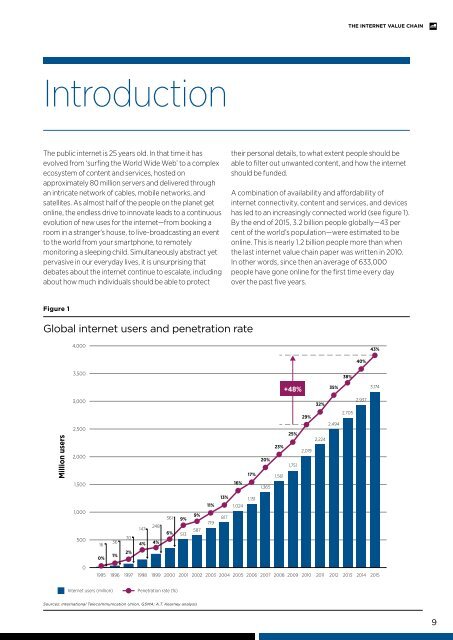The Internet Value Chain
GSMA_The-internet-Value-Chain_WEB
GSMA_The-internet-Value-Chain_WEB
You also want an ePaper? Increase the reach of your titles
YUMPU automatically turns print PDFs into web optimized ePapers that Google loves.
THE INTERNET VALUE CHAIN<br />
Introduction<br />
<strong>The</strong> public internet is 25 years old. In that time it has<br />
evolved from ‘surfing the World Wide Web’ to a complex<br />
ecosystem of content and services, hosted on<br />
approximately 80 million servers and delivered through<br />
an intricate network of cables, mobile networks, and<br />
satellites. As almost half of the people on the planet get<br />
online, the endless drive to innovate leads to a continuous<br />
evolution of new uses for the internet—from booking a<br />
room in a stranger's house, to live-broadcasting an event<br />
to the world from your smartphone, to remotely<br />
monitoring a sleeping child. Simultaneously abstract yet<br />
pervasive in our everyday lives, it is unsurprising that<br />
debates about the internet continue to escalate, including<br />
about how much individuals should be able to protect<br />
their personal details, to what extent people should be<br />
able to filter out unwanted content, and how the internet<br />
should be funded.<br />
A combination of availability and affordability of<br />
internet connectivity, content and services, and devices<br />
has led to an increasingly connected world (see figure 1).<br />
By the end of 2015, 3.2 billion people globally—43 per<br />
cent of the world’s population—were estimated to be<br />
online. This is nearly 1.2 billion people more than when<br />
the last internet value chain paper was written in 2010.<br />
In other words, since then an average of 633,000<br />
people have gone online for the first time every day<br />
over the past five years.<br />
Figure 1<br />
Global internet users and penetration rate<br />
4,000<br />
43%<br />
40%<br />
3,500<br />
38%<br />
+48%<br />
35%<br />
3,174<br />
3,000<br />
32%<br />
2,937<br />
Million users<br />
2,500<br />
2,000<br />
1,500<br />
16%<br />
17%<br />
20%<br />
1,365<br />
23%<br />
1,561<br />
25%<br />
1,751<br />
29%<br />
2,019<br />
2,224<br />
2,705<br />
2,494<br />
1,000<br />
500<br />
0<br />
147<br />
70<br />
36<br />
16<br />
4%<br />
2%<br />
1%<br />
0%<br />
1995 1996 1997 1998<br />
13% 1,151<br />
11% 1,024<br />
9%<br />
361 9%<br />
817<br />
719<br />
248<br />
587<br />
6% 513<br />
4%<br />
1999 2000 2001 2002 2003 2004 2005 2006 2007 2008 2009 2010 2011 2012 2013 2014 2015<br />
<strong>Internet</strong> users (million)<br />
Penetration rate (%)<br />
Sources: International Telecommunication Union, GSMA; A.T. Kearney analysis<br />
9


